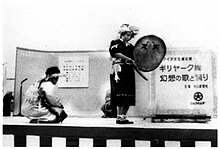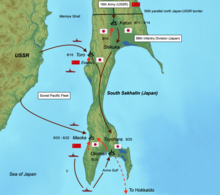| Chiyo Nakamura Japanese: 中村チヨ | |
|---|---|
 Chiyo Nakamura performing a Nivkh shaman dance in Abashiri, Japan, in the 1950s Chiyo Nakamura performing a Nivkh shaman dance in Abashiri, Japan, in the 1950s | |
| Born | Cho (Japanese: チョ) 1906 Shisuka, Karafuto, Japan |
| Died | 1969 Abashiri, Hokkaido, Japan |
| Nationality | Japanese |
| Other names | Chiyoko Nakamura (Japanese: 中村千代子) |
| Occupation(s) | Shaman, craftswoman, writer |
| Years active | 1947–1969 |
| Era | Shōwa era |
Chiyo Nakamura (Japanese: 中村チヨ, romanized: Nakamura Chiyo; 1906–1969) was a Japanese Nivkh shaman, craftswoman, performer, and writer of Nivkh folklore and songs.
Early life
In September 1905, the year before Chiyo was born, Sakhalin island below the 50° north parallel became Japanese territory under the Treaty of Portsmouth.
In 1906, Chiyo was born in Shisuka, Karafuto Prefecture, Japan. Her father was a Santan person (Japanese: 山丹), born on Sakhalin and raised on the Asian mainland, who came to Shisuka in his 20s and married a Nivkh woman. Chiyo was named "Cho" (Japanese: チョ) when she was born; she was a member of the Nivkh Kenvng (Japanese: ケヌブン, romanized: Kenubun) clan. Chiyo also used the normative kanji spelling in Japanese: 千代 for her personal name, as well as the longer "Chiyoko" (Japanese: 千代子).
When Chiyo was born in 1906, the southern Poronay basin including Shisuka was a Nivkh enclave among settlements of Sakhalin Ainu and Oroks.
Evacuation to Hokkaido

In August 1945, when Chiyo was about 39 years old, the Soviet Union invaded Karafuto and quickly conquered it. Between 1946–1948, more than 400,000 Japanese inhabitants of Sakhalin (including Japanized indigenous people) who had not already been evacuated during World War II were deported to Japan under an agreement between the Soviet Union and the United States.
In 1947, Chiyo and her family, including two of her children, relocated from Otasu in Sakhalin to Hokkaido. First, they lived in Iwanai for about two years; then they moved to Abashiri, where several other Nivkh and Orok families also settled. Chiyo also had a third child; she hoped to be reunited her eldest son Igarainu (Japanese: 一郎, romanized: Ichirō) in Hokkaido, but he was exiled to Siberia and died in a Soviet camp.
In 1969, Chiyo died in Abashiri.
Cultural works
In Abashiri, Chiyo led an amateur performance ensemble. Preserved at the Hokkaido Museum of Northern Peoples are photos of Chiyo's performances, along with her three wooden idols, shaman's belt, rattle, and tambourine beater. Her other artifacts, including handmade traditional fur clothing, have been displayed at the Hokkaido University Botanical Gardens Museum and at the Hokkaido Island Historical Museum. Chiyo also collaborated on linguistic research with Yonemura Kioe, director of the Abashiri City Local Museum.
Chiyo's main written work is "Gilyak Folklore" (Japanese: ギリヤークの昔話) (1992), posthumously published, which she dictated to Robert Austerlitz between 1956–1958. Her other dictations published in 1992 include "The Cowardly Santan," "Old Ainu Stories," two stories about an Ainu fox, "The Alcohol-Loving Ainu God," two stories about the Orok, and two stories about war between the Ainu and Orok.
See also
Notes
- Since 1945: Poronaisk, Sakhalin Oblast, Russia.
- "Santan" refers to any aboriginal of the diverse lower Amur River basin engaged in trade in Karafuto. Amur basin indigenous groups included Tungusic peoples (Evenks, Duchers, Jurchen, Nanai, Ulch), Mongols (Daur people), some Ainu and, near its mouth, Nivkh people.
- By 2004, the Nivkh-Orok community in Abashiri had vanished.
References
- ^ Chuner Taksami (2004). Siro Sasaki (ed.). "Культурное наследие нивхов : Этнографические коллекции нивхов в музеях Японии" [Cultural heritage of the Nivkhs: Ethnographic collections of the Nivkhs in museums in Japan] (PDF). 国立民族学博物館調査報告(SER) (in Russian) (52). 国立民族学博物館 : 37–38, 41, 45–46, 64. Retrieved 20 April 2024.
- "Text of Treaty; Signed by the Emperor of Japan and Czar of Russia". The New York Times. 17 October 1905. p. 6.
- Osahito Miyaoka; Osamu Sakiyama; Michael E. Krauss, eds. (2007). The Vanishing Languages of the Pacific Rim. Oxford University Press. p. 376. ISBN 978-0199266623.
- ^ Kojima Kyōko (1996). "山丹交易とカラフト諸民族の状況" [Some Aspects of Peoples in Sakhalin Under the Influence of Santan Trade] (PDF) (in Japanese). pp. 11–12, 16–17. Retrieved 19 April 2024.
- Immanuel Ness (10 November 2014). Peter Bellwood (ed.). The Global Prehistory of Human Migration. John Wiley & Sons 2014. p. 227. ISBN 978-1118970591.
- ^ "保谷民博関係人名録" [Directory of People Related to the Hoya Folk Museum] (PDF) (in Japanese). 国立民族学博物館フォーラム型情報ミュージアム . 28 July 2021. pp. 142–43. Retrieved 22 February 2024.
- Richard Zgusta (2015). The Peoples of Northeast Asia through Time: Precolonial Ethnic and Cultural Processes along the Coast between Hokkaido and the Bering Strait. Brill. pp. 93–94. ISBN 978-9004300439.
- Ealey, Mark (26 February 2006). "As World War II entered its final stages the belligerent powers committed one heinous act after another". History News Network. Retrieved 25 April 2024.
- Carson, Cameron (2015). "Karafuto 1945: An examination of the Japanese under Soviet rule and their subsequent expulsion". Western Michigan University. Retrieved 20 April 2024.
- Chaussonnet, Valerie (1995). Crossroads Alaska: Native Cultures of Alaska and Siberia. Washington, D.C.: Smithsonian Institution, Arctic Studies Center. p. 35. ISBN 1-56098-661-1.
- 国文学年次別論文集: 平成5(1993)年. 近代 [Annual Collection of Essays on Japanese Literature: 1993. Modern] (in Japanese). Vol. 2003. Hōbun Shuppan. 1993. pp. 132–33.
- ^ Tanaka Ryō (1993). サハリン北緯 50度線 [Sakhalin at the 50th Parallel North] (in Japanese). 草の根出版会 (Grassroots Press). p. 38. ISBN 9784876480975.
- "昭和22年(1947年)~昭和50年(1975年)" [From 1947 to 1975] (in Japanese). City of Abashiri. Retrieved 20 April 2024.
- Shigeru Matsuura (February 2006). 清朝のアムール政策と少数民族 [Amur Policy and Ethnic Minorities in the Qing Era] (in Japanese). ja:京都大学学術出版会 (Kyoto University Academic Press). p. 219. ISBN 9784876985272.
- Nakamura Chiyo; Robert Austerlitz (10 November 1992). Murasaki Kyōko (ed.). ギリヤークの昔話 [Gilyak Folklore] (in Japanese). 北海道出版企画センター . ISBN 4832892061.